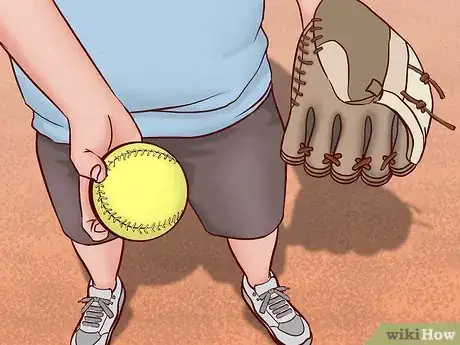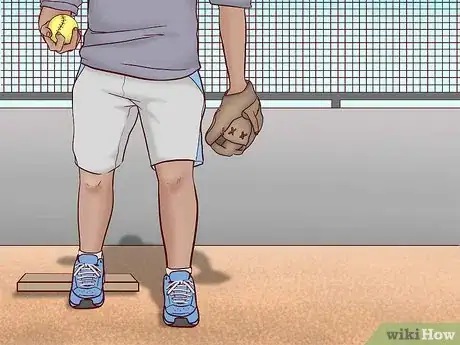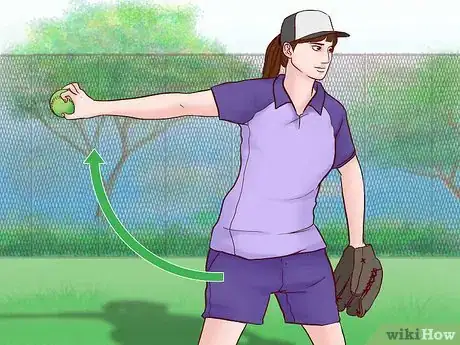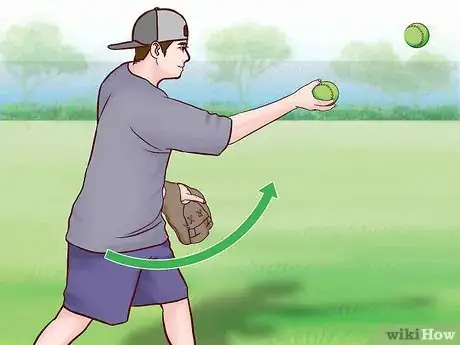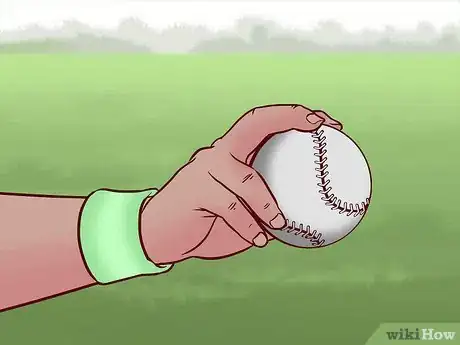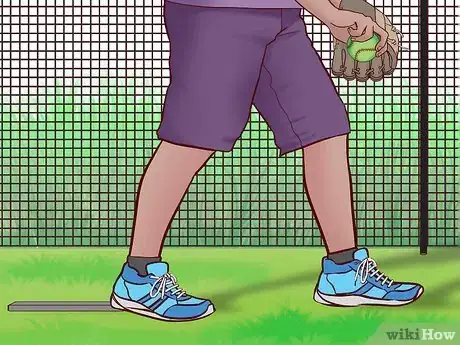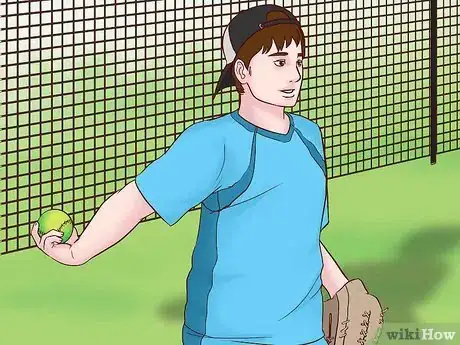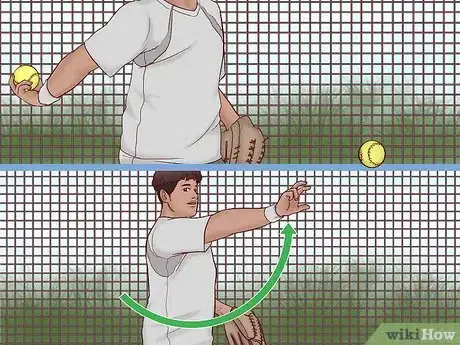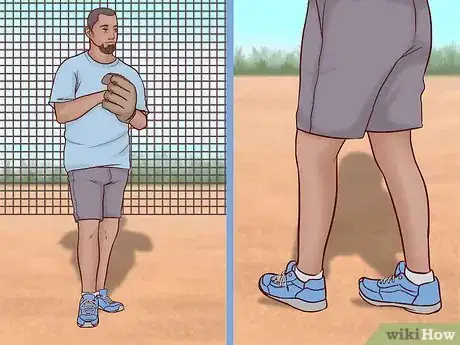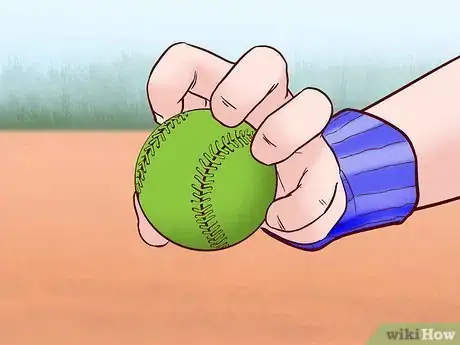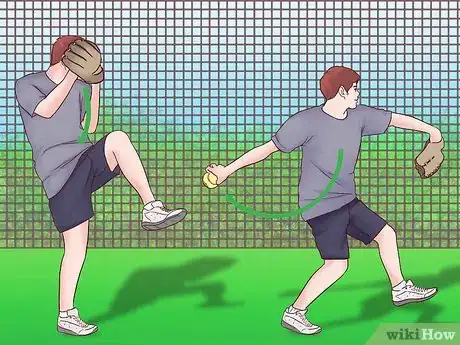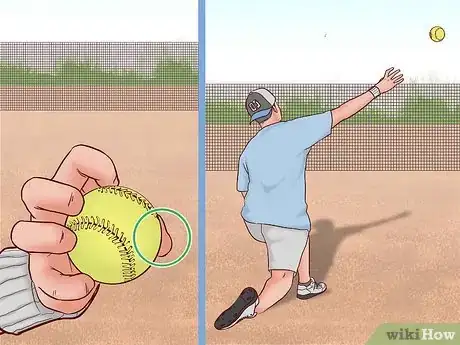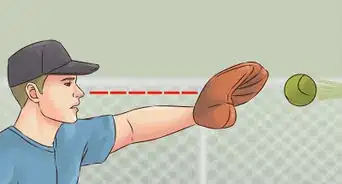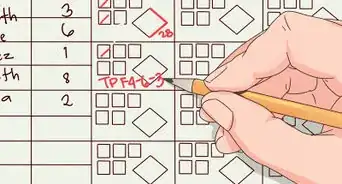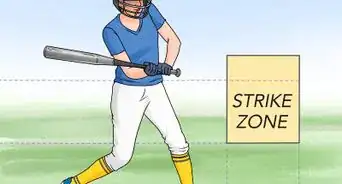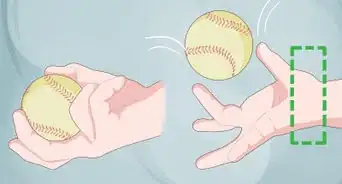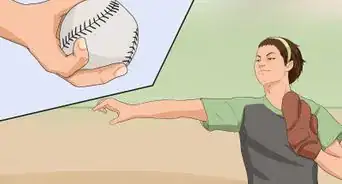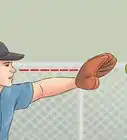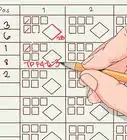This article was co-authored by wikiHow Staff. Our trained team of editors and researchers validate articles for accuracy and comprehensiveness. wikiHow's Content Management Team carefully monitors the work from our editorial staff to ensure that each article is backed by trusted research and meets our high quality standards.
There are 10 references cited in this article, which can be found at the bottom of the page.
This article has been viewed 227,896 times.
Learn more...
Although it might seem easier to pitch slowly, the slow-pitch can be difficult to master. However, pitching this way is a requirement for slow-pitch softball leagues. Practice your underhand throwing technique, and then try out a slow curveball or a knuckleball pitch once you master the basics.
Steps
Using a Basic Underhand Pitch
-
1Hold the ball in the palm of your dominant hand. Make full contact with the ball using your palm and fingers. Wrap your fingers around the ball in a way that feels comfortable to you. Grip the ball tightly using all of your fingers and thumb. Hold the ball tightly enough to keep it in your hand.[1]
- If you are right-handed, hold the ball in your right hand. If you are left-handed, hold the ball in your left hand.
-
2Stand with your feet shoulder width apart and take a step back. Face the direction you want to pitch the ball. Then, take 1 step back with the foot on your dominant side, so that your body is now slightly angled towards your target.[2]
- If this feels unnatural to you, you can also keep your feet together or bend slightly at the waist.
- Make sure to keep your knees soft. Do not lock them!
Advertisement -
3Swing your arm backwards using an underhand motion. Bring your arm back alongside your hip after you take a step back. Hold the ball so that it is just behind you before you start to pitch it. Keep the ball below the level of your waist with your arm out straight.[3]
- Make sure that your palm is facing your target.
-
4Throw the ball underhand as you step forward. Swing the ball forward and upward as you take 1 step ahead with the foot that was positioned behind you. Release the ball right after your arm passes your thigh. Loosen your fingers to release the ball and let the ball fly up and towards your target.[4]
- This movement should be quick, but not too forceful or you may end up getting an excessive speed warning from the umpire.
Tip: Check to see that the ball arcs up at least 3 ft (0.91 m) but no more than 10 ft (3.0 m). This is the ideal height for a slow pitch.[5]
Throwing a Curveball
-
1Hold the ball with your index finger and thumb on opposite seams. Press your palm against the surface of the ball. Then, arrange your fingers so that your index finger is parallel to 1 of the seams and your thumb is parallel to the opposite seam. Grip the ball tightly with your fingers to keep the ball in your hand.[6]
- The rest of your fingers can press against the ball where it feels natural, but focus most of the pressure on the ball with your index finger and thumb.
- Imagine you are gripping a soda can. This is similar to how your index finger and thumb should be positioned on the ball.
-
2Step back and plant your feet firmly on the ground. Check to ensure that your feet are about shoulder-width apart. Then, take 1 step backwards with your dominant foot, which is on the same side as the hand you are using to hold the ball.[7]
- Keep your knees loose, not locked.
-
3Bring the ball behind you with your palm facing up. Use a swinging motion to move the hand holding the ball behind you. Keep your arm straight and the ball below the level of your waist as you do this.[8]
- The ball should be right behind your hips. Bring your arm back to a comfortable position. Don’t overextend it.
-
4Throw the ball and twist your wrist slightly to the left on the release. This will put a spin on the ball after you release it, which may help to make it more challenging to hit. As you bring the ball forward to throw it, turn your wrist by about 90 degrees to the left.[9]
- If you are left-handed, twist the ball to the right as you bring it forward to pitch.
Tip: Do not release the ball too sharply, or it might not be considered a slow pitch. In this case, the umpire may issue an excessive speed warning.[10]
Pitching a Knuckleball
-
1Stand with your feet shoulder-width apart. Plant your feet firmly on the ground so that they are in line with your shoulders and so that the front of your body is angled towards your target. Keep your knees soft and your body loose.[11]
- You may also take a step back with your dominant foot or bend slightly at the hips if this feels natural to you.
Tip: Make sure to stand at a comfortable distance from where you want to pitch the ball. Move closer or further away if needed.
-
2Curl your fingertips under and press them against the ball. Place the ball in your dominant hand so that it is resting in your palm. Then, position your thumb on 1 side of the ball and press your knuckles into the opposite side of the ball along the seams. Use enough pressure to maintain a good grip on the ball.[12]
- If you are right-handed, hold the ball with your right hand. If you are left-handed, hold the ball with your left hand.
-
3Bring the ball behind you before you throw it. Keep a good grip on the ball as you wind it back, and remember to keep it low. Don’t raise it up higher than the level of your waist.[13]
- Hold the ball so that your knuckles are facing in the direction you want to pitch.
-
4Pitch and release the ball with your thumb first and your fingers last. Swing the ball forward with an underhand motion. Keep your knuckles facing ahead and moving in the direction of your target. Loosen your grip on the ball with your thumb first and allow the ball to roll over the tips of your knuckles as you pitch.[14]
- Remember to keep the ball below the level of your waist as you swing forward.
Expert Q&A
-
QuestionHow do you throw a strike in softball?
 Haley SnyderHaley Snyder is a former Division I Student-Athlete and Softball Player. With over a decade of experience, she specializes in softball mechanics, fundamentals, and pitching. Haley holds a BA and MA from Stanford University, where she competed in the PAC-12 Conference as a pitcher.
Haley SnyderHaley Snyder is a former Division I Student-Athlete and Softball Player. With over a decade of experience, she specializes in softball mechanics, fundamentals, and pitching. Haley holds a BA and MA from Stanford University, where she competed in the PAC-12 Conference as a pitcher.
Softball Player Try to keep your body out of the way of your arm. Make sure that you're starting from where you plan on throwing the ball—you don't want to step the left or right and have your arm cross over your body. Instead, focus on having a motion where you're striding and creating a lane for your arm to move through. This is the best way to get consistent accuracy!
Try to keep your body out of the way of your arm. Make sure that you're starting from where you plan on throwing the ball—you don't want to step the left or right and have your arm cross over your body. Instead, focus on having a motion where you're striding and creating a lane for your arm to move through. This is the best way to get consistent accuracy!
Warnings
- Check your league rules. Leagues will make their own rules regarding pitch height, the strike zone, and pitching motion.⧼thumbs_response⧽
References
- ↑ https://www.youtube.com/watch?v=-HwRnGNYwMg&t=18
- ↑ https://www.youtube.com/watch?v=-HwRnGNYwMg&t=24
- ↑ https://www.youtube.com/watch?v=-HwRnGNYwMg&t=24
- ↑ https://www.youtube.com/watch?v=-HwRnGNYwMg&t=30
- ↑ https://usssa.com/docs/2018/2018_SP_RuleBook.pdf
- ↑ https://www.youtube.com/watch?v=rF8etqi9bSA&t=12
- ↑ https://www.youtube.com/watch?v=rF8etqi9bSA&t=23
- ↑ https://www.youtube.com/watch?v=rF8etqi9bSA&t=23
- ↑ https://www.youtube.com/watch?v=rF8etqi9bSA&t=27
About This Article
Pitching a softball slowly can take a little getting used to, but with the right technique and practice, you’ll get the hang of it. Hold the ball in your palm and wrap all of your fingers and thumb around it. Stand with your feet shoulder width apart, then take one step back with your dominant foot so your body is slightly angled towards your target. After you step back, swing your arm backwards in an underhand motion, keeping the ball below your waist. Then, step forward with your dominant foot and swing the ball forward and upward. Release the ball right after your arm passes your thigh to pitch it at your target. For more tips, including how to throw a curveball in slow-pitch softball, read on!
